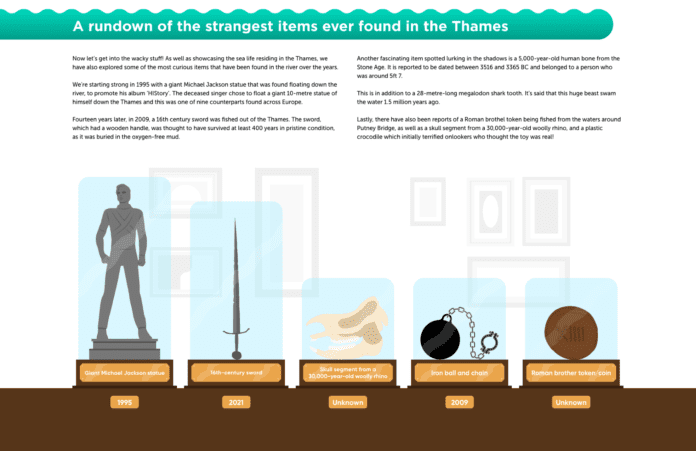- Data finds that whales are the most common animal residing in the Thames, besides fish
- Bones, swords, and animal teeth are among items spotted in the river
- Food wrappers are the top lightweight item found, making up 20% of all litter in the Thames
The River Thames is one of London’s oldest and most popular attractions, not only bringing in millions of overseas visitors each year but piquing local interest too.
As well as being a tourist hotspot, it is England’s longest river and the second-longest river in the United Kingdom.
This got us thinking, how much of the Thames is undiscovered?
The team at Barratt London have taken a deep dive into the waters to reveal what tropical marine life resides in the river, the wackiest items that have been found as well as which items could be recycled.
What are the weirdest and wackiest items that have ever been found?
The study took a deep dive into the 30-million-year-old river to discover the strangest items which have been fished out of the river.
We’re starting strong in 1995 with a giant Michael Jackson statue that was found floating down the river, which the singer used to promote his album ‘HIStory’.
There have also been reports of a Roman brothel token being fished from the waters around Putney Bridge, as well as a skull segment from a 30,000-year-old woolly rhino and a plastic crocodile, which initially terrified onlookers who thought the toy was real.
Strangest items ever found in the Thames:
| Item | Year Sighted |
| 5,000-year-old human bone | 2022 |
| 16th Century Sword | 2021 |
| Plastic Crocodile | 2017 |
| Iron Ball and Chain | 2009 |
| Giant Michael Jackson Statue | 1995 |
| 28-metre-long megalodon shark tooth | Year Unknown |
| Roman Brothel Token | Year Unknown |
| Skull segment from a 30,000-year-old woolly Rhino | Year Unknown |
What sea life can be spotted in the Thames?
The Thames is a perfect place to spot marine life, with the river being home to everything from whales, dolphins, seals, crabs, and eels.
The study found that the most common sea creature that resides in the river besides fish are whales. These wonderful marine mammals have been sighted in the river as early as 2006 and sightings date all the way up to this year. Various types of whales have been found living in the river including the humpback, bottlenose, beluga and minke species.
Along with whales, some other animals that have been found in the capital’s waterway are dolphins, a harbour porpoise, several sharks, seahorses and eels.
Animals found residing in the Thames:
| Animal | Species Spotted | First Spotted |
| Whale | Humpback, Bottlenose, Beluga and Minke | 2006 |
| Dolphins | 2018 | |
| Harbour Porpoise | 2019 | |
| Shark | Starry Smooth-Hound, Tope and Spurdog | 2021 |
| Seal | Grey and Harbour | 2013 |
| Eel | 2013 | |
| Mitten Crab | 2019 | |
| Seahorse | Short-Snouted | 2013 |
| Loch Ness Monster | 2021 | |
| Redshank | 2021 |
What waste items are found most in the Thames?
Finally, the study explored the waste items found in the Thames that shouldn’t have ended up there as well as the top lightweight items that have been fished from the river.
The research also delved into which areas are wet wipe, plastic bag and general waste hotspots.
Wet wipes are reported to be the most littered item in the river and when mixed with mud they form slimy layers. One of these mounds was 1.4 meters which covered 1000m2, which is the equivalent to four tennis courts. After hearing that, we certainly won’t be taking a dip in the Thames anytime soon.
Hammersmith Bridge Southside landed the top spot for wet wipes with Newcastle Draw Dock coming out on top for plastic bags whilst Small Profits Dock takes the top spot for floating waste.
Wet wipe, plastic bag and floating waste hotspots:
| Rank | Wet Wipe Hotspots | Plastic Bag Hotspots | Floating Waste Hotspots |
| 1 | Hammersmith Bridge Southside | Newcastle Draw Dock | Small Profits Dock |
| 2 | Fulham Football Club | 02 Flats in Greenwich | Queen Caroline Draw Dock |
| 3 | Battersea Bridge | Galleons Point | Crabtree Wharf |
Now onto lightweight items. The study found that food wrappers are the top lightweight item, with them making up a fifth (20%) of all lightweight items floating on the foreshore of the Thames between 2015-2018.
Top lightweight items found in the Thames:
| Top Lightweight items found | % of the total litter found |
| Food Wrappers | 20% |
| Cotton Bud Sticks | 16% |
| Cups | 9% |
| Bottle Lids | 8% |
| Take-away Containers | 8% |
| Drinks Bottles | 3% |
| Building Insulation (polystyrene / foam) | 2% |
| Straws | 2% |
| Cigarette Butts | 2% |
| Lollipop Sticks | 1% |
Ed McCoy, Sales and Marketing Director at Barratt West London, said: “Discovering that a number of whales have chosen to make Londoners their neighbours has been quite a pleasant and unexpected surprise. Their under the radar presence makes them the perfect quiet and considerate neighbours. It’s a privilege to share our city with them.
“The study also brought to light the items that should not be calling the Thames home, that could have very easily been recycled instead. We hope this new knowledge of our underwater neighbours will make a lot of people think twice about dumping rubbish into the Thames.”
Who knew there were so many hidden treasures in the Thames?
Help keep news FREE for our readers
Supporting your local community newspaper/online news outlet is crucial now more than ever. If you believe in independent journalism, then consider making a valuable contribution by making a one-time or monthly donation. We operate in rural areas where providing unbiased news can be challenging. Read More About Supporting The West Wales Chronicle


























